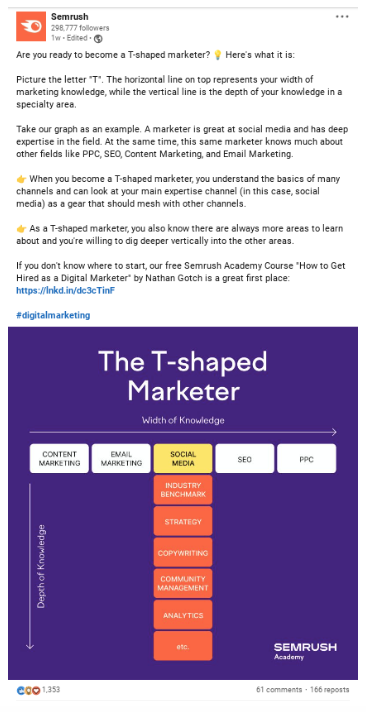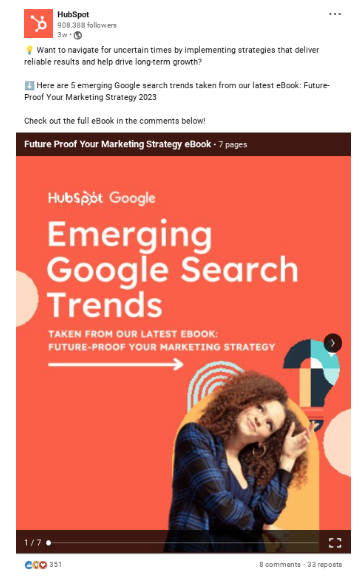5 Ideas for Repurposing Your SEO Content
Alastair Kane Search Marketing, Search Marketing PartnerRead it in 7 minutes
Read it in 7 minutes
Table of contents
Are you sure you’re maximising the value of your existing content?
Most B2B content marketers are time-strapped and juggling multiple priorities – always thinking ahead to the next campaign on the list; the next pillar page, blog post, or eBook.
It’s easy to set and forget. Most of us are guilty of publishing a piece of content, promoting it for a short time, and then leaving it to stagnate.
But with all the effort that goes into content creation, it’s a shame not to make your content work harder.
Repurposing your blog and pillar page content helps you get more value out of it, benefits your multi-channel marketing strategy, and saves time that would otherwise need to be spent on creating evergreen content.
Most marketers already know this, yet they’re not doing it consistently. Indeed, 61% of marketers claim that repurposing content is the most effective tactic, but only 29% have a strategy for content repurposing.
Here are 5 things you should be considering for every pillar page or blog article you create…
Starting with what’s probably the most obvious repurposing tactic, you can produce tens of social posts from a single pillar page. And at least 3 or 4 from a blog post!
As well as linking to the main post, you can turn the content into ‘microblogs’ that focus on a particular area of the content. LinkedIn posts have been getting longer in recent years, as the platform favours posts which keep users in the platform rather than taking them off to a website.
OkDork analysed post performance on LinkedIn and found that “on average, the longer the post, the better. Posts with large word counts perform well. Posts between 1900 and 2000 words perform the best and gain the greatest number of post views, likes, comments, and shares.” However, make sure you space text out, and use emojis, hashtags, and a relevant graphic to support engagement.
Here’s an example of a post from Semrush (it’s fairly long and performs well):

You can also pull out key stats, findings and quotes into individual image cards and share blog and pillar pages multiple times, with different captions, to see what works best.
This stat from Accenture clearly makes an impact:

However, it’s worth structuring your content calendar so that you’re spacing out your content repurposing. For example, repurposing and sharing the content a month or two after you originally published so that you’re not posting the same topic too many times in a row.
Carousels are one of the top performing content formats on LinkedIn. Uploaded as a PDF (or PowerPoint) document, users click through the content or swipe right if they’re on mobile.
Use key points, takeaways or stats from your blog/pillar content to tell a story.
Top tips for creating an engaging carousel:
Here’s an example from HubSpot:

There’s a reason why every second post on LinkedIn seems to be a carousel! As well as letting you explore a topic in more depth than you would with a single image, carousels are more interactive as users have to scroll through the content, carousels take up more space on the feed than other content – giving your audience more of an opportunity to pause and engage. 57% of LinkedIn users access the site on a mobile device so your carousel could take up their whole screen!
As your SEO strategy is looking to answer common buyer challenges, the SEO-optimised content you produce should be highly relevant. Consider stitching together existing blogs and pillar page content to produce a more comprehensive downloadable asset, such as an eBook or guide.
HubSpot recommends doing this for relevant pillar pages, and including a download button at the end to allow visitors to download the content and read it offline.
Ensure you include a CTA at the end of the guide to give the reader a next step, such as reading a case study or booking a product demo.
And if you’ve got an in-person event coming up such as a customer conference, you could have the guide printed to give to attendees.
(Then repurpose your guide into a carousel…)
If you’ve written a series of posts or a pillar page on a topic that’s complex or difficult to digest, having one of the experts from your organisation talk it through on a webinar or podcast can make it more accessible for your audience.
If you don’t have your own podcast, then one of your subject matter experts could feature on as a guest on an industry podcast, armed with insights from your blog content.
Alternatively, running a webinar can help you generate leads and help position your brand as a thought leader. The webinar hosts can use your pillar page or blog content as the foundation of their webinar content – whether they choose to run it as more of a presentation or a fireside conversation, they can expand on the themes you’ve covered in your content.
As well as turning your blog posts and pillar pages into new assets that you can use across multiple channels, it’s also important to regularly audit your website and see which pieces of content would benefit from an update.
Elements like statistics or news can quickly become outdated; ensuring that the information on your website is still relevant and correct helps maintain trust with your audience, and shows you’re ahead of industry trends.
Assess your existing content and choose whether to:
Then repurpose, repackage and repromote!
Not every one of these ideas will be appropriate for every piece of pillar page or blog content you produce (and you probably won’t have time to do them all). But this gives you a checklist to work through to help you squeeze more value out of your content and reduce the amount you need to create from scratch.
Repurposing content helps you to reach and engage new audiences, reinforce your message, and test which formats your audience finds most engaging.
By putting more effort into content repurposing, the time and resources you invest in your SEO strategy will start to benefit your wider marketing objectives — driving awareness, traffic and engagement across multiple channels.
Happy repurposing!
Sign up to receive B2B Search Marketing Insights direct to your inbox
Book a call to discuss your business' search marketing needs
Book a call